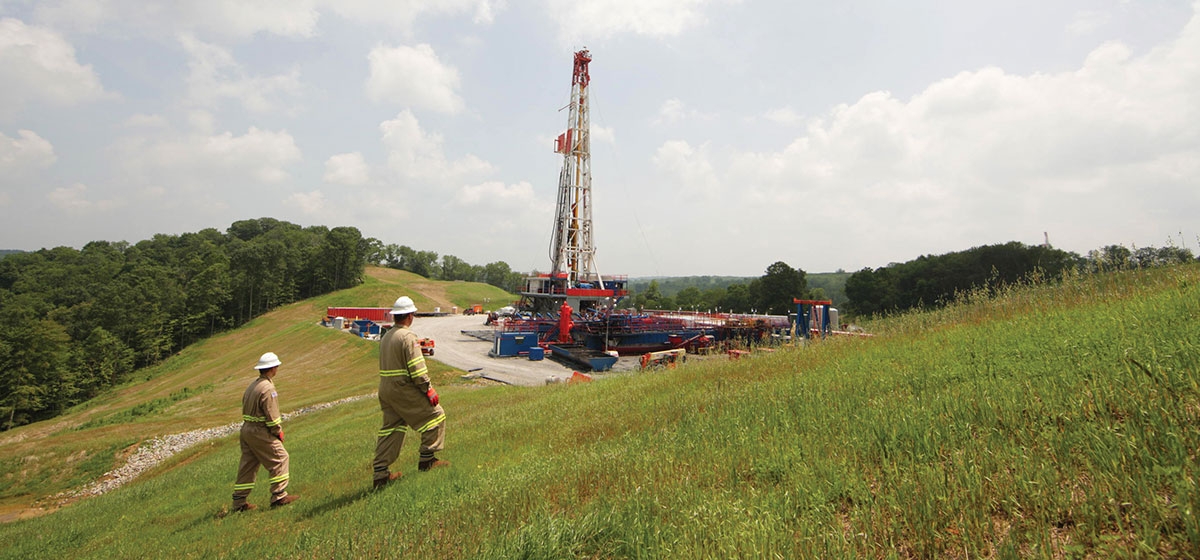
For years the well pads, truck traffic and logos of energy companies large and small multiplied across counties like Washington and Greene as southwestern Pennsylvania became a poster child for the rush to extract natural gas trapped in the Marcellus Shale.
It was in such a climate that the region recently assumed a new identity as a place where efforts to stake a middle ground in the polarized debate over drilling and environmental protection are seen as so advanced that they’re drawing interest from regulators and elected officials from countries as far away as Kazakhstan.
A group of energy companies, environmental nonprofits and foundations known as the Center for Sustainable Shale Development (CSSD) emerged from two years of closed-door negotiations last March to announce they’d agreed on voluntary standards that raise the bar on protecting the air and water in communities where drillers operate. And unlike industry best practices, they coupled the standards with a certification process that audits a driller’s compliance. The idea is to promote state-of-the-art environmental practices throughout the Appalachian Basin shale play with the hope that drillers who earn certification will gain a competitive edge that will provide an incentive for others to follow suit.
It’s been applauded and criticized. Much of the attention has focused on the fact that a group of unlikely partners bridged the partisan divide to reach a consensus on environmental standards for shale gas drilling, rather than on what those standards specifically require certified drillers to do.
CSSD partners have implied that the first set of environmental standards require certified drillers to raise their practices above the floor set by state and federal regulations. A Pittsburgh Today review of those standards and Pennsylvania law finds that to be generally true.
Team of rivals
The idea of finding a group of companies and environmental nonprofits willing to look for ways to reduce the environmental risks posed by shale drilling had been explored three years ago in Pittsburgh by the Heinz Endowments with little success. John Hanger had better luck. The former state Department of Environmental Protection secretary and one-time director of Pennsylvania’s largest environmental nonprofit drew on his sense of who might be willing to take on such a task and recruited four major energy companies with shale gas operations and five local, state and national environmental nonprofits as partners in what is now CSSD.
The partners include energy producers CONSOL Energy, EQT, Chevron and Shell. Two national environmental nonprofits, the Environmental Defense Fund and Clean Air Task Force, signed on with the Pennsylvania Environmental Council, Citizens for Pennsylvania’s Future, and the Group Against Smog and Pollution, a Pittsburgh-based grassroots organization. The Heinz Endowments and William Penn Foundation are involved as philanthropic partners. And the advisory board includes former U.S. Secretary of the Treasury and Alcoa Chairman and CEO Paul O’Neill and former U.S. Environmental Protection Agency Administrator Christine Todd Whitman.
Assembling a team hand-picked for their willingness to tolerate divergent points of view and rely on science and facts as guidance rather than dogma and rhetoric proved critical at a time when public debate over fracking was dominated by intransigent voices.
“You had two strong polarities and neither were helpful. In fact, they were detrimental to finding the best outcomes for the Commonwealth and region,” says Andrew Place, director of energy and policy at EQT, who is serving as CSSD interim director. “Some on the industry side were the proverbial, ‘drill baby drill; stay out of our way, we know what we are doing.’ On the other side there was, ‘these molecules should stay in the ground, fossil fuel is not the way to go;’ ‘it can’t be done, the risks are too great.’ None of us felt that was the way this debate should go.” Negotiations were fragile at times, particularly in the beginning. But with engineers and scientists at the table, the group was able to deal with drilling-related environmental issues as technical problems that needed to be solved. “The right people were in the room,” says Place. “Over time, what occurred was relationships were built and people put ideas forward that they would not have been interested in doing or have been willing to do if it had been a very public debate.”
The result was a set of 15 standards for the industry that prescribed practices intended to better protect air and water quality. The partners agreed the standards would be open to improvement and that standards addressing other environmental concerns such as terrestrial issues and community impact would be added in coming years.
They also agreed to a certification process requiring drillers who embrace the standards to submit to third-party audits to verify their compliance, not unlike that which the Green Building Council requires developers to pass in order to earn Leadership in Energy and Environmental Design (LEED) certification for their buildings.
For the companies involved, the standards were seen as a way to lower the risk of environmental mishaps, help secure a “social license” to develop the abundant shale gas play and assure an uncertain public, whose mixed views on drilling were documented last year in the Pittsburgh Regional Environment Survey conducted by Pittsburgh Today. The survey found that about 79 percent of residents across the Pittsburgh Metropolitan Statistical Area (MSA) believe drilling offers significant or moderate economic opportunities to the region. At the same time, 59 percent see it as a significant or moderate threat to public health and the environment.
Few, if any, environmental nonprofits consider current drilling regulations sufficient to protect the environment. And several that agreed to join CSSD reported that the decision was not without internal debate over the pros and cons. For some, reasons for choosing to sit at the table included the hope of avoiding the hard lessons of the past, such as those from coal mining, which left a legacy of tainted streams and other problems.
“We want to make sure that this time we have some control of what happens and ride herd on the industry to make sure this is done to the best of everybody’s ability,” says Davitt Woodwell, executive vice president of the Pennsylvania Environment Council’ s Western Region. “Anyone who can’t do it to the best of their ability, shouldn’t be doing it.”
And the reality of what’s taking place in the hills and valleys of southwestern Pennsylvania added urgency to the idea of addressing the risks while waiting for slow-moving regulations to catch up. “Whether you support drilling, are absolutely opposed to drilling, or are somewhere in the middle, you have to acknowledge the industry is here, right now,” says Joe Osborne, the Group Against Smog and Pollution’s legal director. “You can’t ignore the impact it’s having, regardless of how you think things ought to be in an ideal world.”
Interest, praise & scorn
CSSD drew worldwide attention almost immediately. In Paris, announcement of its standards created a buzz at the International Energy Agency meeting on unconventional natural gas last March. And throughout the year, CSSD officials hosted delegations of regulators, elected officials, journalists and others from Austria, Britain, China, Canada, France, Germany, Kazakhstan, Ukraine and the European Union who traveled to Pittsburgh to learn about the standards and the process that led to them.
Editorial writers from Pittsburgh to Dallas applauded the launch of CSSD. The Washington Post, for instance, described it as a “heartening breakthrough in the war over fracking.” On the other hand, several environmental nonprofits not invited to negotiate the standards criticized those who were, suggesting their involvement amounted to capitulation to an untrustworthy industry.
The Sierra Club, the nation’s largest grassroots environmental organization, took issue with the fact the standards don’t carry the weight of law. “Voluntary certification is akin to slapping a Band-Aid on a gaping wound,” wrote Deb Nardone, director of its Beyond Natural Gas campaign.
The nonprofit Public Accountability Initiative was more personal, documenting how several CSSD partners and board members have industry ties ranging from seats on corporate boards to investments in energy companies. In a report, the nonprofit described CSSD as a “greenwashing” campaign, implying that its standards are more of a marketing ploy than an attempt to advance environmental practices in shale gas drilling. The report, however, offered no evidence that the nonprofit had actually evaluated the merit of the CSSD standards.
Tougher, for the most part
Pittsburgh Today compared the 15 CSSD air and water standards to Pennsylvania and federal regulations that address environmental issues related to unconventional natural gas drilling. Both are rife with complexities. It is not uncommon, for example, for a single CSSD standard to have several parts that prescribe multiple practices, timetables and specifications.
Each of the 15 standards was found to require CSSD-certified drillers to take some degree of protective action not prescribed by state or federal law. How significantly those practices rise above an operator’s legal obligations varies across standards.
Some CSSD standards are similar to existing regulations, save for a measure or two that can have environmental importance. One example is the standard for earthen impoundments that store water discharged during drilling that’s fouled by chemical additives, brine and other contaminants. Like CSSD, Pennsylvania has design requirements that include double lining the impoundments. But unlike the state, CSSD also requires operators to remove hydrocarbons from the water before it is stored and to take steps to prevent wildlife from entering the impoundment.
CSSD standards also prohibit discharging drilling wastewater into streams and rivers, allowing no exceptions. Zero discharge is generally promoted by Pennsylvania regulations. But under state law, public water treatment plants can, under certain circumstances, accept wastewater, which some have done, raising controversy and concern over public water supplies.
Some similarities are also seen in CSSD standards and state regulations related to how drillers deal with the contaminated water discharged when a well is being drilled and afterward. Both call for drillers to identify strategies for reducing wastewater. But CSSD requires a recycling plan, and CSSD requires drillers to recycle at least 90 percent of their wastewater. Such practice reduces the amount of fresh water consumed in the hydrofracturing process, which is measured in the millions of gallons. State regulations don’t require drillers to recycle their wastewater.
Regulations tend to be moving targets, and recent changes have blunted the impact of one CSSD standard that was written earlier. That standard places limits on emissions from compressor engines used to push gas through pipelines after a well has gone into production. While those limits are more stringent than federal rules, Pennsylvania’s revised regulations are, in some instances, more demanding.
But several CSSD standards advance environmentally protective practices well beyond what is called for in state and federal regulations.
One is the approach taken toward protecting groundwater. Before drilling, the CSSD standards require companies to establish an “area of review” that includes the vertical and horizontal legs of a well and to perform an analysis to characterize the geology below. That includes looking at whether the subsurface confining layers can prevent fracking fluids from migrating in unintended ways. It also includes identifying orphaned wells, faults or other vulnerabilities that might pose a problem. State regulations don’t require drillers to perform such geological risk analyses. Operators who are CSSD-certified also must monitor streams, aquifers and other water sources within a 2,500-foot radius of the wellhead for at least one year after the well is drilled and show that the quality and chemistry of the water measured before drilling hasn’t been adversely affected. State law doesn’t require operators to take such steps to see if their wells impact local water sources.
CSSD emissions standards for the diesel engines used in drilling and in the heavy trucks hauling fresh water and contaminated water are more restrictive than those which operators are legally required follow. Diesel engines are prolific sources of fine particles that contribute to smog, which is of growing concern in areas where drilling is concentrated.
At least 95 percent of a CSSD-certified driller’s truck fleet, for example, must meet the most stringent federal emissions regulations within three years. The standard applies to both new and existing trucks, including those bought before 2007, which could account for a large share of an operator’s fleet. Federal law exempts those older trucks. And federal law prohibits Pennsylvania and other states from regulating them on their own.
Moving forward
Before leaving CSSD to begin his Pennsylvania gubernatorial campaign, Hanger expressed hope the standards would encourage more effective environmental practices within the industry, derail the argument that such higher standards cannot be met by the industry, and, through market pressures, require companies to earn certification in order to drill in the Appalachian Basin states.
Whether that will come to pass remains to be seen. It took the better part of last year for CSSD to piece together its certification process, including protocols for selecting and training the auditors who’ll monitor compliance. Their audits are expected to include both documentation review and field inspections.
Sometime in 2014, the first companies to seek certification are expected to undergo compliance audits. Those presumably will be the four CSSD corporate partners: CONSOL, EQT, Shell and Chevron Appalachia. How many more will follow is unclear, as is the extent to which CSSD is supported within the shale gas industry.
The region’s largest shale gas trade group, the Marcellus Shale Coalition, hasn’t endorsed CSSD, which is not mentioned on the group’s website or on its list of the positive industry developments of 2013. And the group did not respond to interview requests to clarify its position on CSSD.
But the notion that CSSD standards could create market demand for drillers to adopt its standards got an early and unexpected boost in September when Allegheny County added several of the standards to its request for proposals to extract gas under Deer Lakes Park. “I think it’s doing the right thing,” says Allegheny County Chief Executive Rich Fitzgerald. “Everything is on a case-by-case basis. But we’d like to set a baseline where, if we can get some of these enhancements, it could be a template for doing it in other areas—not just public land, but private land as well.”





